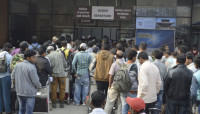Columns
A riddle, wrapped in a mystery
What ideological identity the Nepal Communist Party subscribes to remains unclear..jpg&w=900&height=601)
Lok Raj Baral
Started in Calcutta (now Kolkata) in 1949, the Nepal Communist Party has since been swinging from one end to the other to find its proper place in the country's conflicting political atmosphere. The source of inspiration of 'communist' leaders and their actual orientation in Western liberal democratic principles and practices were not only contradictory, but they even went to denouncing the liberal system as bourgeoisie and antagonistic to their own brand of communism. But surprisingly, from its very birth, the leaders were constrained to adopt a liberal multiparty system. In 1959, they, like any other party, joined the first ever held parliamentary election under a constitution that accepted the king as sovereign. In the post-1960 coup period, the party split into numerous groups and personalities accusing each other of ideological deviation.
Swayed by the strong appeals of communism then being experimented in the Soviet Union and later in China, the young Nepalis had a mission of transforming the feudalistic Nepali society in line with Marxism-Leninism and Maoism. The Nepal Communist Party’s first split had started with the open rift between the Soviet Union and the Chinese Communist Party following the rise of Nikita S Khrushchev and his denunciation of Joseph Stalin for his alleged brutalities and the personality cult that he developed after Lenin’s death. In fact, all communist parties of the world polarised into Soviet and Chinese (Mao) camps, so much so that the two rival communist powers, Soviet Russia and Moist China, engaged in a border war in the late 1960s. The Chinese called the Russian brand as 'revisionism' that deviated from Marxism and Leninism, thus claiming China as the sole representative of the 'communist world'.
In Nepal, the pro-Soviet group broke with the anti-monarchical groups then operating from India. A few others directly and indirectly supported the partyless regime, finding some excuses that the royal regime was guided by nationalism. At a time when all shades of opposition were weak to mount any decisive movement in the country, many top-ranking leaders of both the communist and non-communist camps adopted a moderate position to build rapport with the king. The Nepali Congress, a party that was hard hit by the coup, offered cooperation with the king for 'further development of the constitution' whereupon BP Koirala and Ganesh Man Singh were released from jail after eight years and other leaders living in India got amnesty. To counter Koirala’s threat of an armed revolution that he declared after his release, king Mahendra also released Man Mohan Adhikari and Shambhu Ram Shrestha who, predictably, pledged ‘loyal’ cooperation and support to the king for developing the nation and safeguarding national sovereignty. They also applauded the progress made by Nepal over the past few years (in the 1960s) and praised its policy of neutrality. But Pushpa Lal Shrestha continued to oppose the regime calling himself a republican.
It is interesting to note that no communist group including that of Pushpa Lal supported the 'Jhapali group' when it went berserk in the name of 'liquidation of class enemies' and killed some noted people without any evidence. According to their own judgment, those who were killed were local exploiters and agents of the government. Inspired by the Naxalite movement across the border in India, the Jhapali group (Marxist-Leninist) subsequently renounced violence, but continued mobilising the youth on the basis of their achieved popularity. This group had denounced the national referendum declared by king Birendra in 1979 for ascertaining the opinion of the people whether or not they preferred a multiparty system instead of the 'no-party system' enforced by the regime after the 1960 coup. The Marxist-Leninist group interpreted the restoration of the multiparty system as a virtual restoration of the Nepali Congress in another guise.
However, confronted with functional inconvenience after the end of the royal regime in 1990, Madan Bhandari, then general secretary, decided to transform his party into a parliamentary one. Pragmatic as he was, Bhandari roped in the moderate groups led by Man Mohan Adhikari and Sahana Pradhan (widow of Pushpa Lal) and formed the Communist Party of Nepal (Unified Marxist-Leninist). It could fare well in the 1991 parliamentary elections making it the second largest party after the Nepali Congress. The mid-term election triggered by GP Koirala paved the way for experimenting with all types of governments—minority and coalition of diametrically opposite forces. The meteoric rise of the Communist Party of Nepal (Unified Marxist-Leninist) eventually paved the way for an almost two-thirds government in 2016 when the former Maoists also dissolved themselves into a new party—Nepal Communist Party. Although many other smaller groups are outside this combination, the mainstream communist party has now dominated the political scene boasting, as Prachanda declared, of 50 years’ rule.
All parties including the Nepal Communist Party are parties for power, not for ideological pursuit. While the Nepal Communist Party wants to keep its credentials of being a progressive party with all the clichés of communism and socialism, its twists and turns and strong will to grab power have put it in a dilemma over whether or not it should go on changing its identity. As if the party has used the parliamentary process and its constitution as convenient ways to power, its newfound love seems to be Chinese President Xi Jinping’s path—'socialism with Chinese characteristics in a New Era'. To be precise, Xi’s path aims to make China a nation with pioneering global influence and world class military force, eradicate poverty, create a level playing field for business and open up the country’s markets. And the Belt and Road Initiative is one of the significant aspects of Xi’s doctrine. Many countries that have accepted the Belt and Road Initiative hope that they will benefit immensely as it entails development and connectivity. Nevertheless, what dividend it will pay is not known as yet.
Nepal’s immediate neighbours want to open channels at all levels. A desire to establish party-to-party level contact is nothing new. Politicians of many other countries have participated in parties’ conventions in order to show solidarity and camaraderie. However, the high-level drama staged for the orientation of Xi Jinping’s thoughts among the members of the Nepal Communist Party was singled out for comments by both the main opposition Nepali Congress and a wide spectrum of independent observers. They raised their eyebrows when both the Nepal Communist Party government and party were together to be educated in Xi’s thoughts. China is basically a one-party state whose top leader cannot be removed at intervals. The Nepal Communist Party, on the other hand, is committed to multiparty plural democracy as enshrined in the constitution of Nepal. If the Nepal Communist Party embraces the Xi doctrine and tries to implement it, that will be yet another acrobatic move of the party that may not necessarily do good for its present status. What ideological identity it subscribes to remains as what Winston Churchill described Soviet foreign policy in 1939—'a riddle, wrapped in a mystery, inside an enigma'. Will the Nepal Communist Party be able to maintain the identity of a party that has achieved its present status through a competitive political mechanism and not through a one-party controlled system?
***
What do you think?
Dear reader, we’d like to hear from you. We regularly publish letters to the editor on contemporary issues or direct responses to something the Post has recently published. Please send your letters to [email protected] with "Letter to the Editor" in the subject line. Please include your name, location, and a contact address so one of our editors can reach out to you.




 19.12°C Kathmandu
19.12°C Kathmandu













%20(1).jpg&w=300&height=200)

